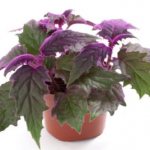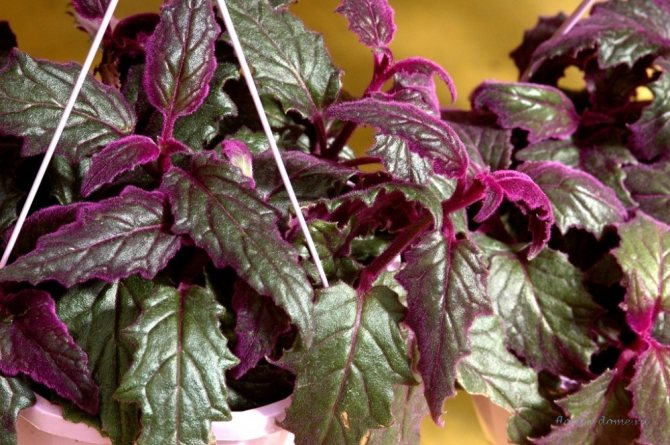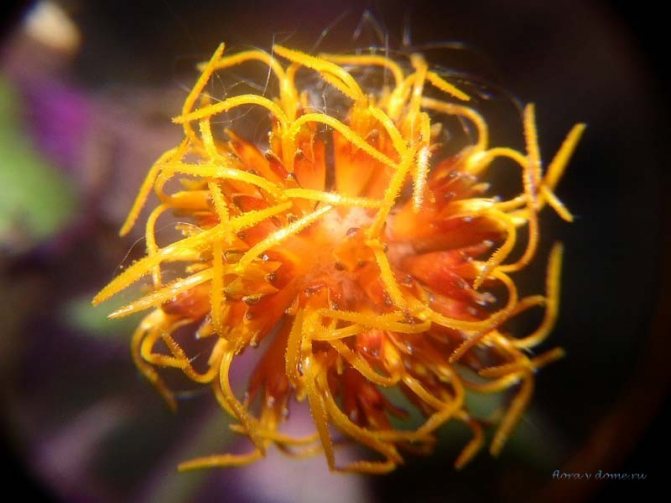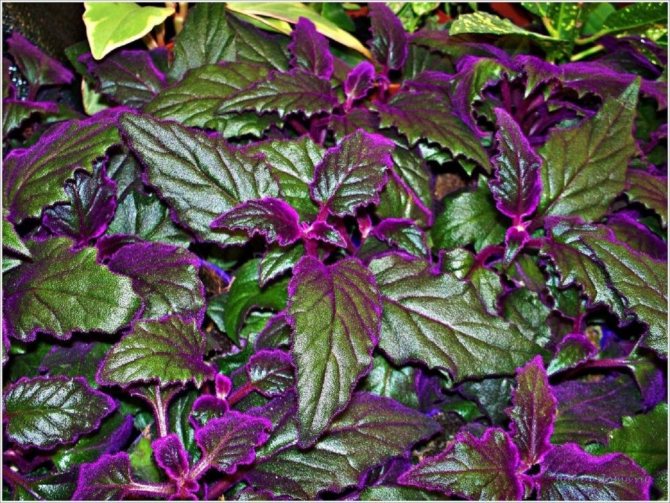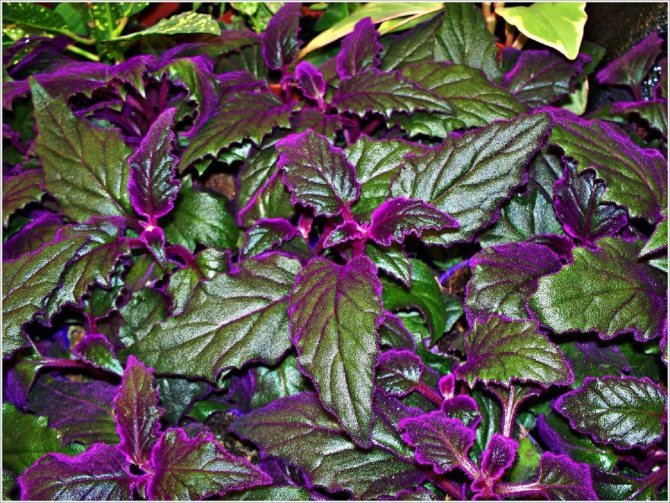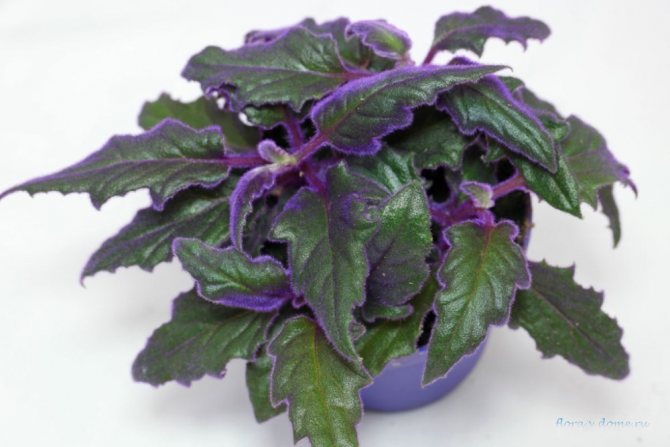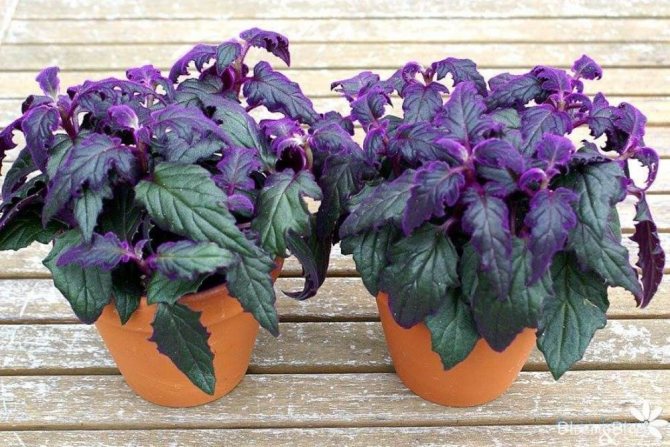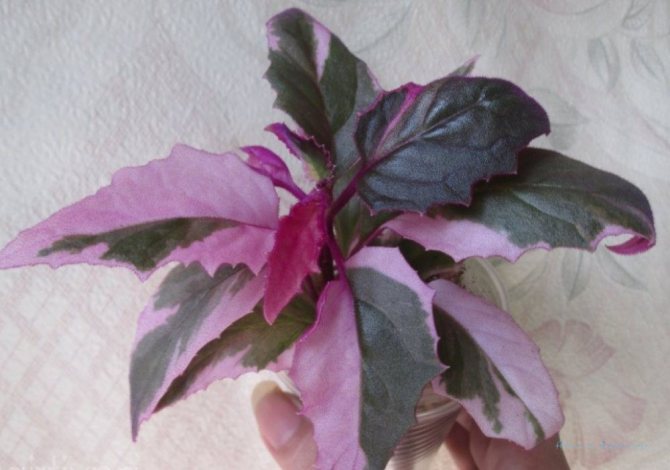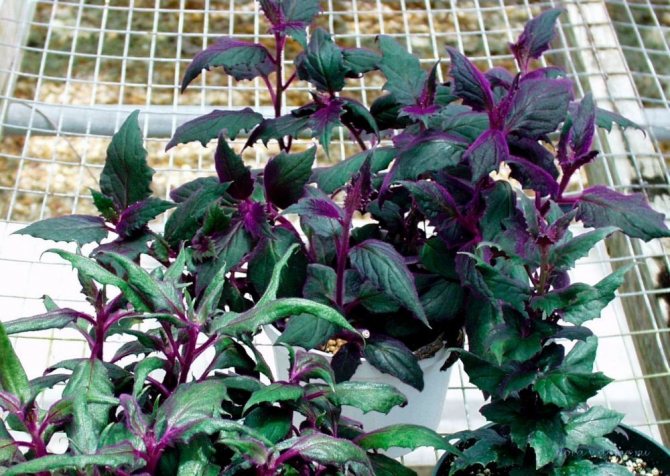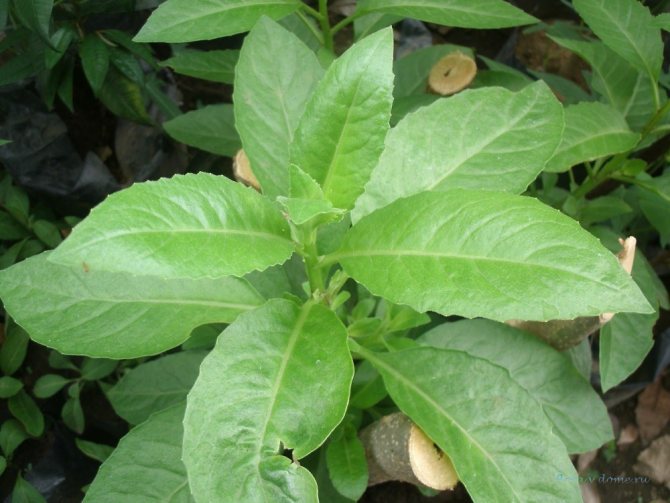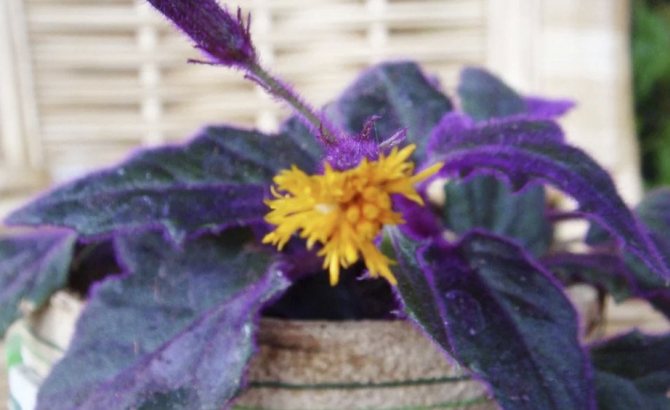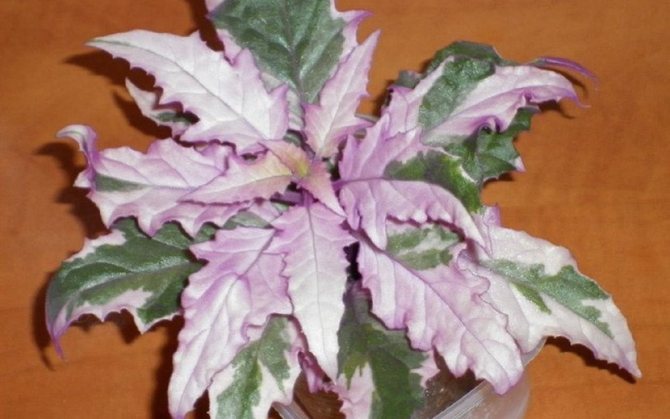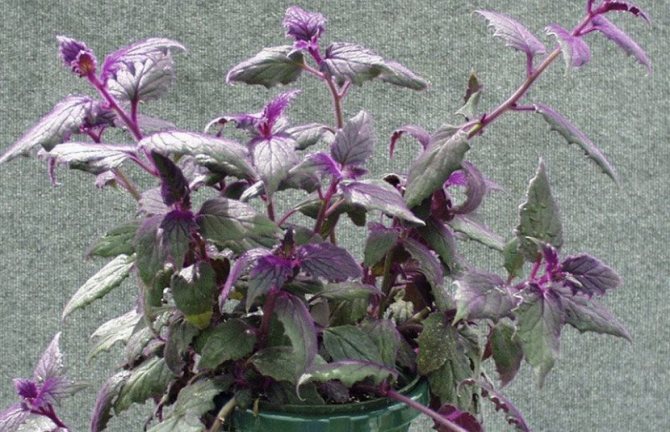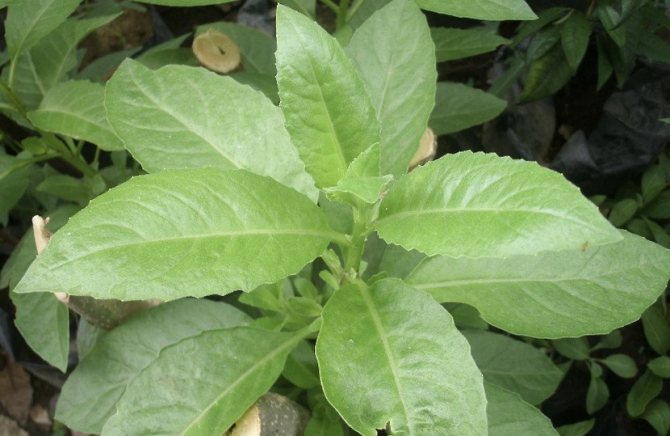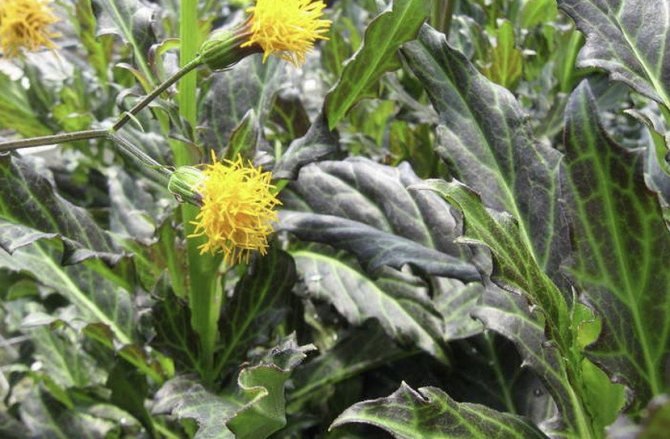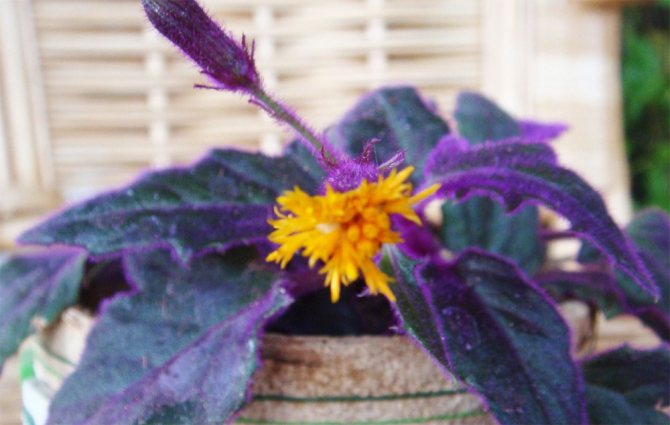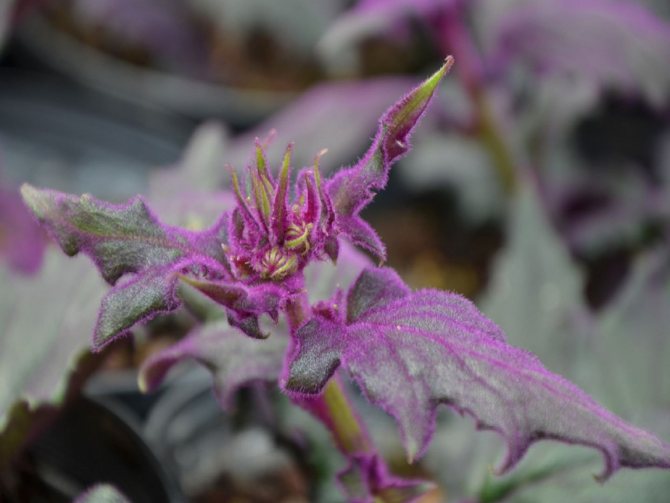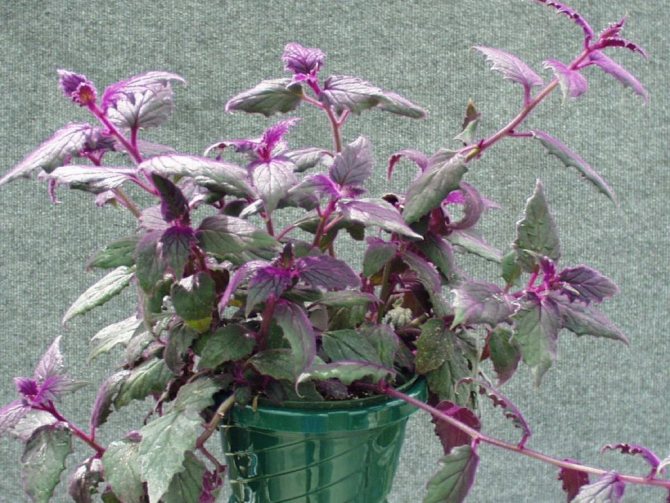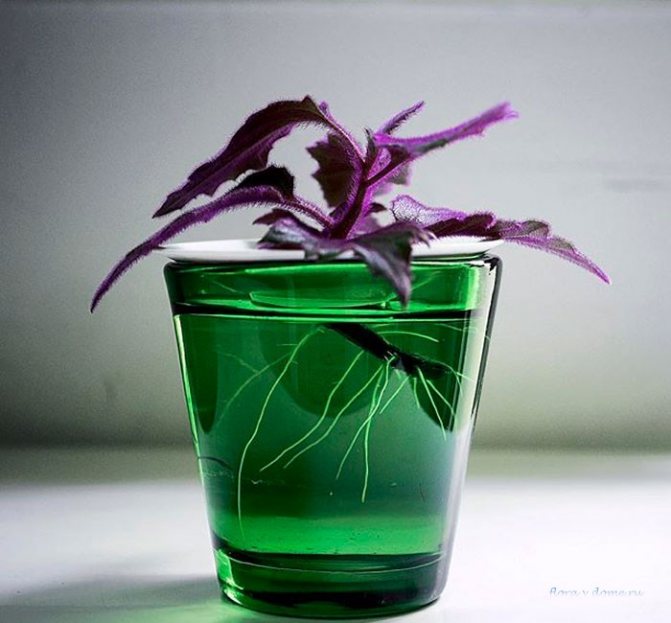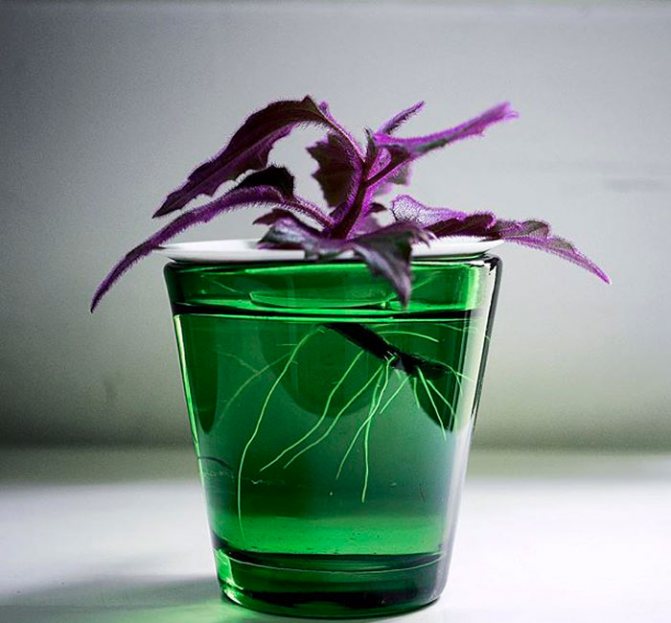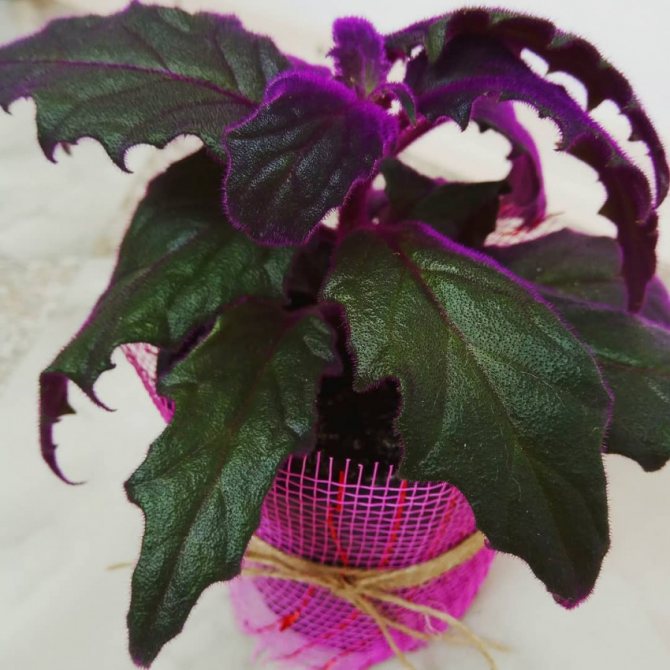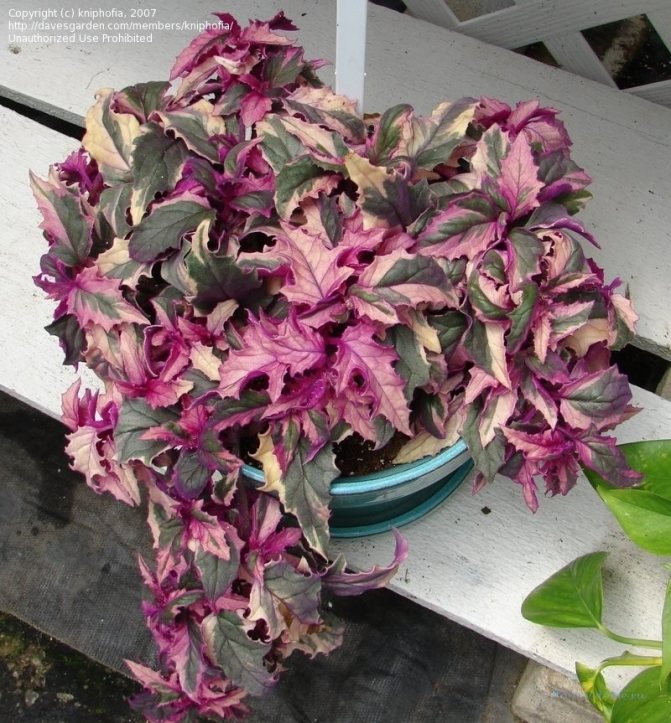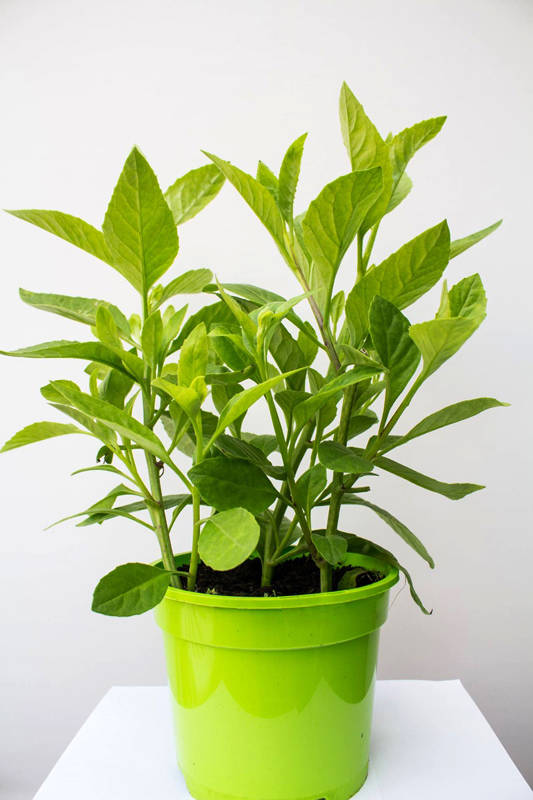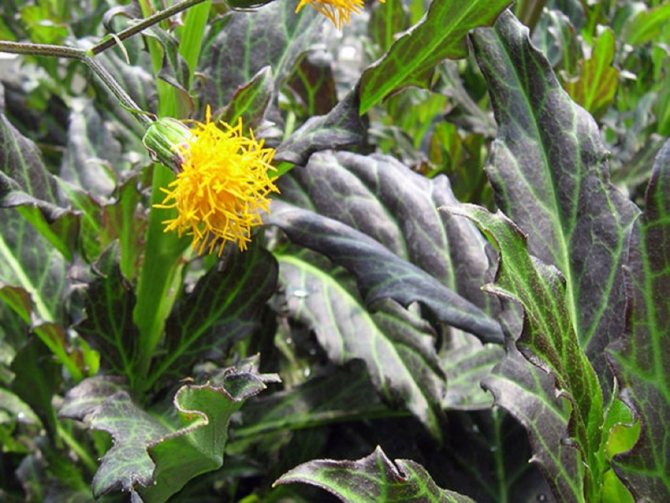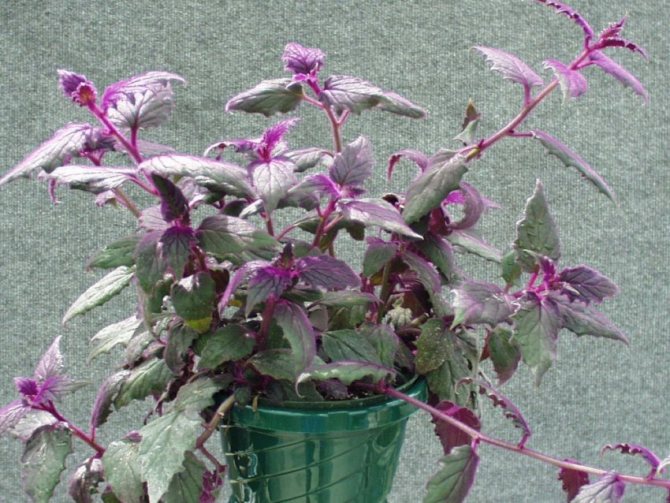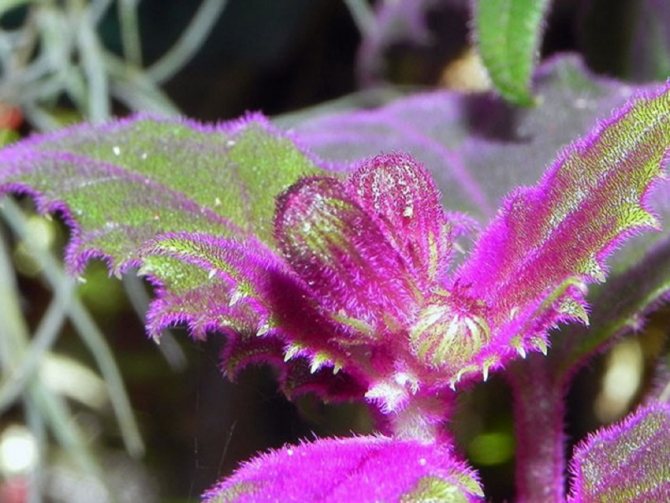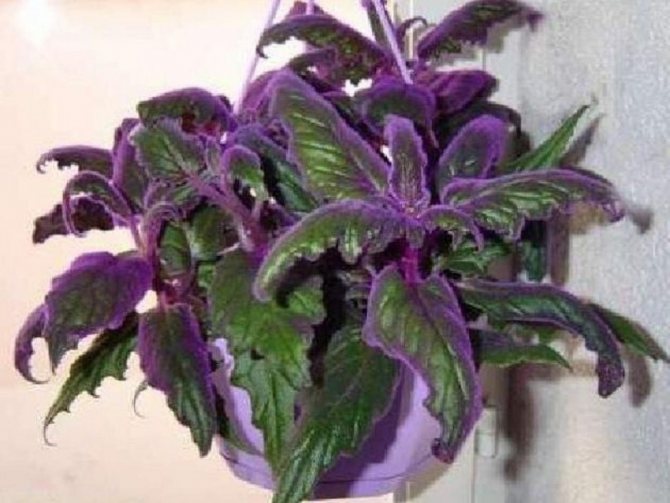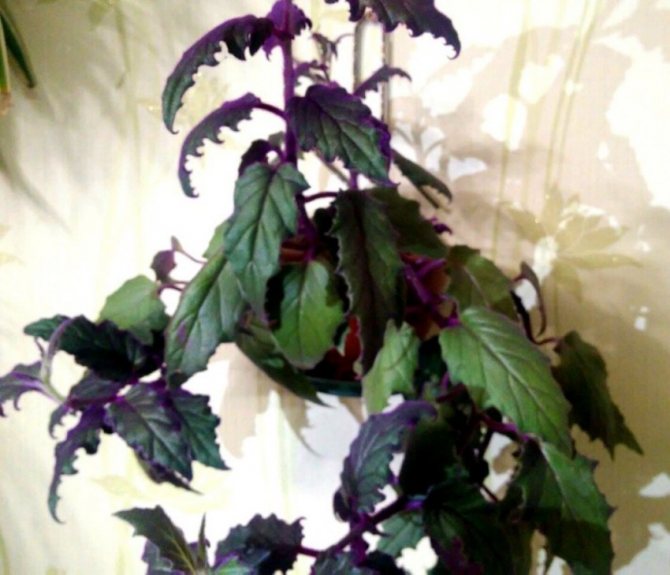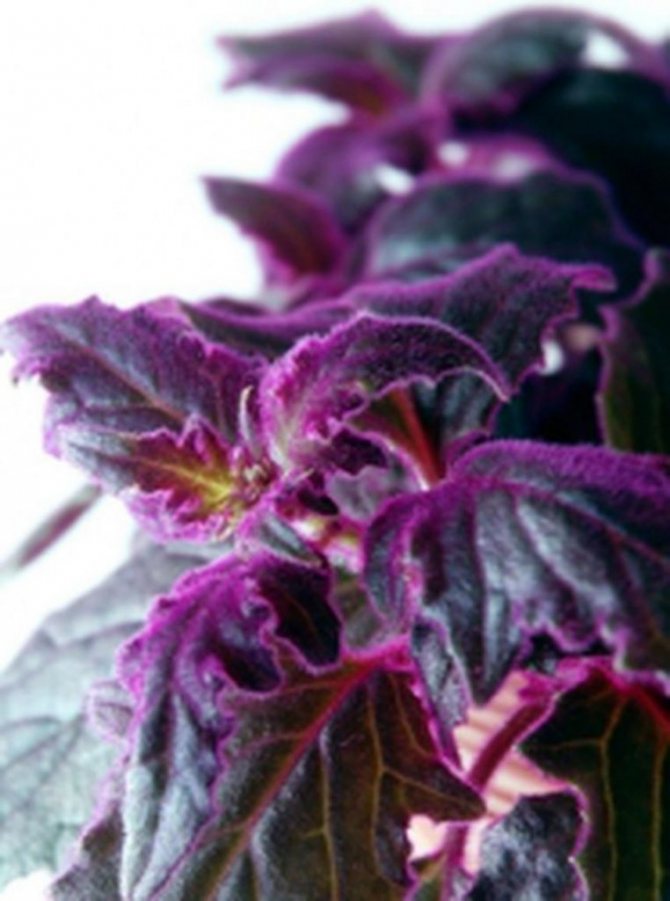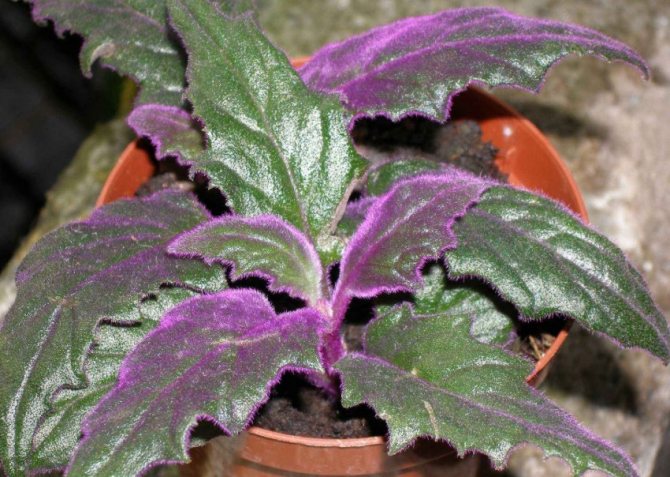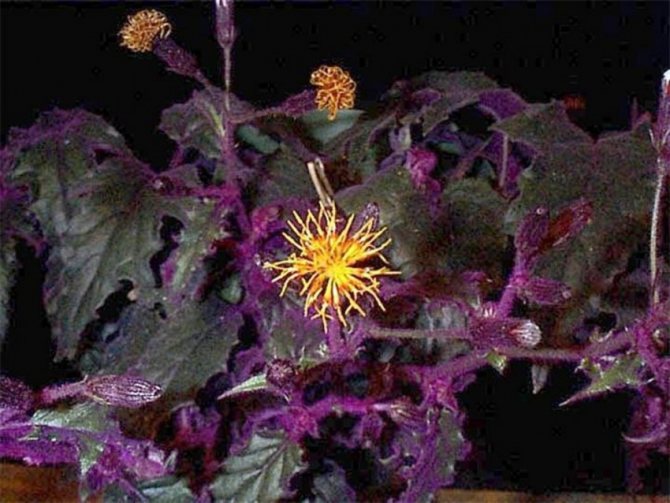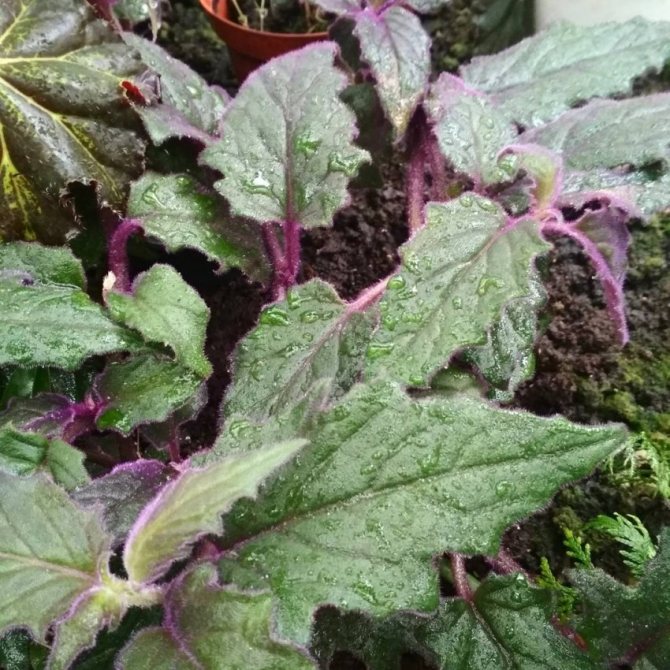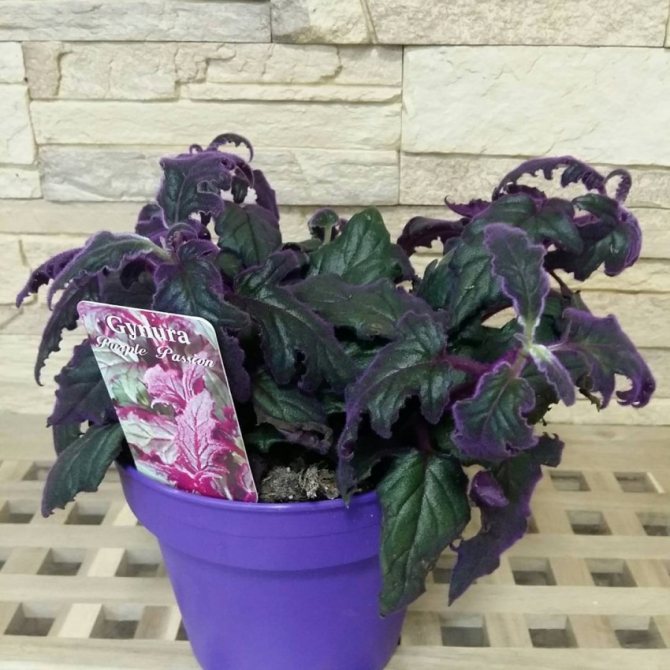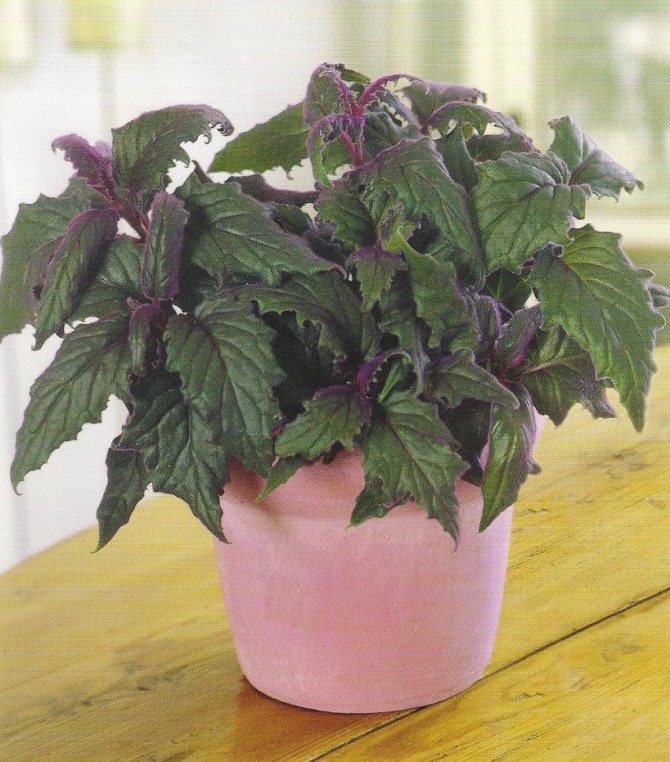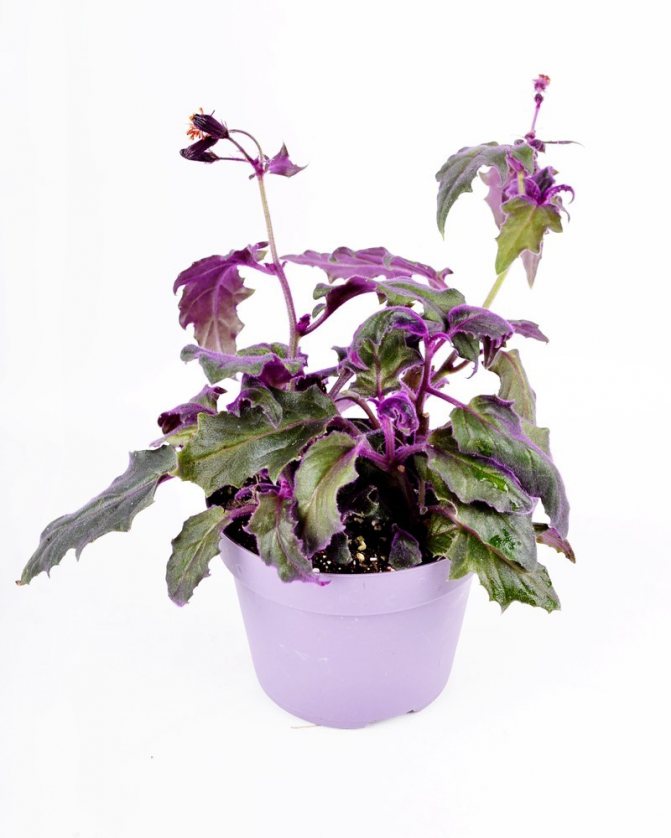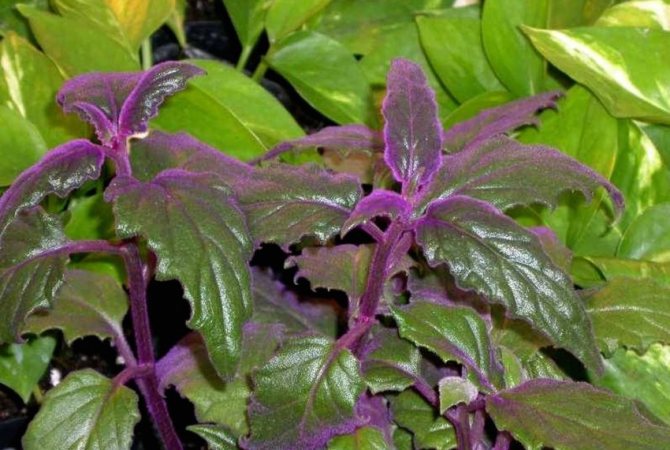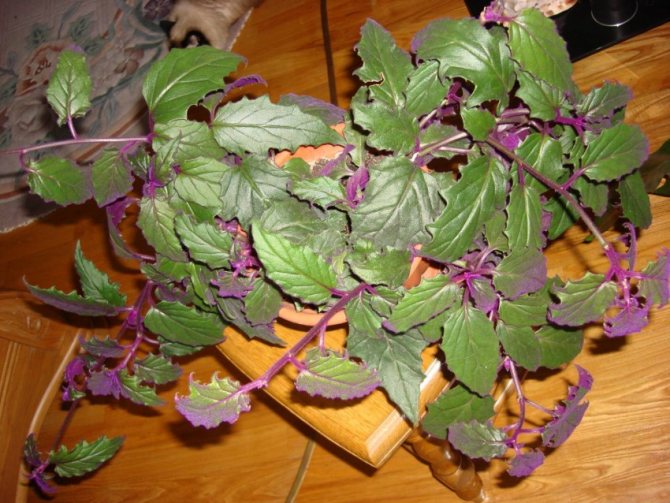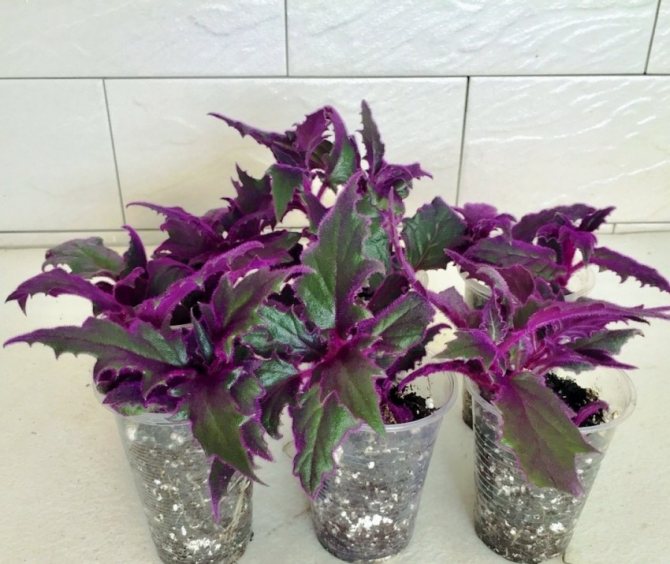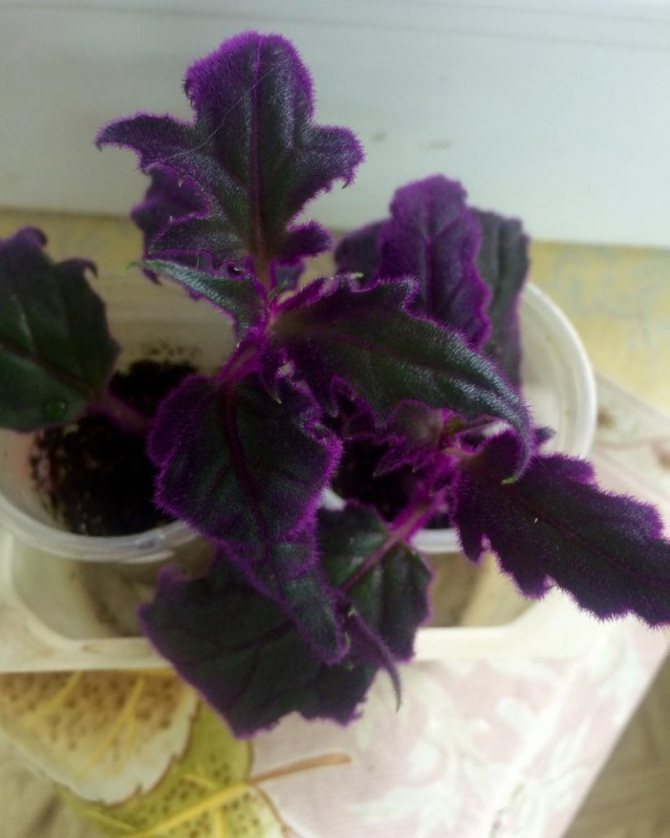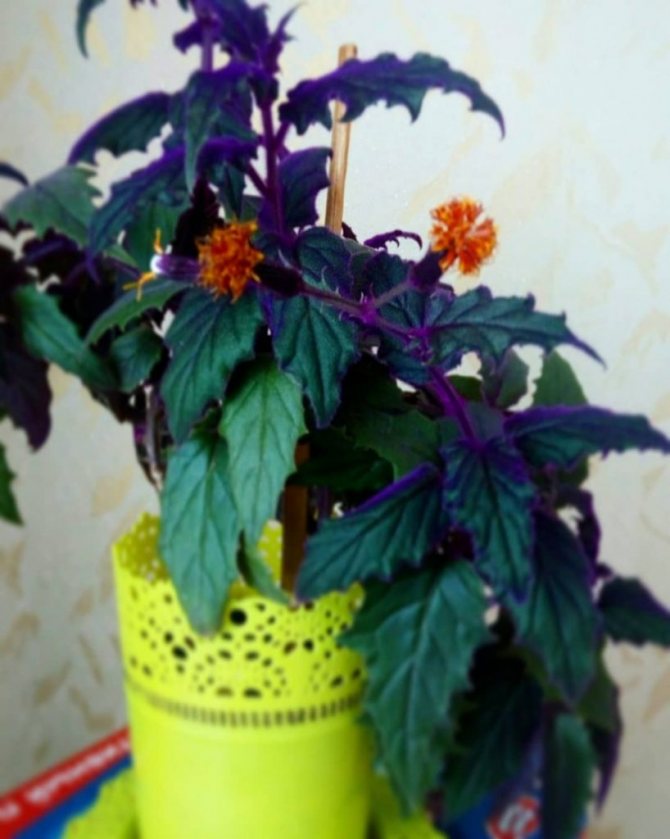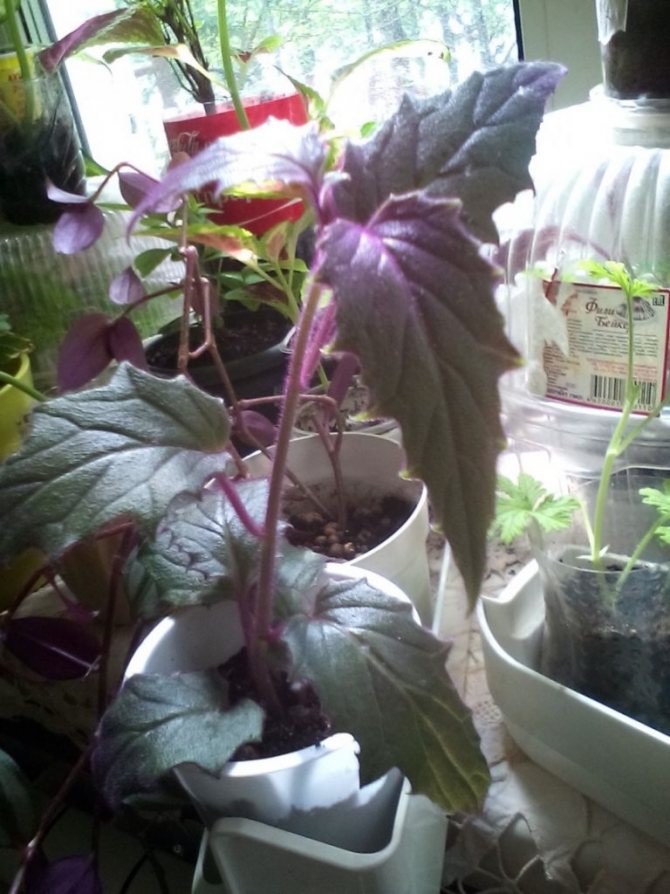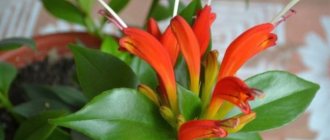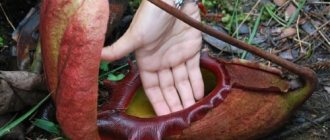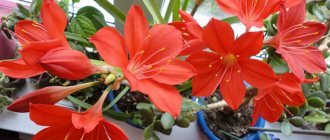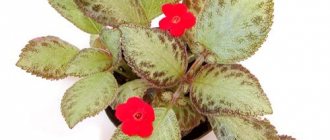The plant grows profusely and is usually used in decoration as an ampelous one, decorating the interiors of rooms and balconies. But Ginura grown in wide pots also looks elegant on the windowsill.
The leaves are green with a purple border. The transition of the dark green leaves to the purple shade of the stem and veins looks very impressive. Ginura was dubbed the “blue bird” for her extraordinary color scheme.
Unlike leaves, Ginura's flowers have no decorative value and smell unpleasant, so the peduncles are immediately cut off as they appear. Reproduction takes place by cuttings, which must be planted in slightly moistened neutral soils.
Ginura: types and varieties for growing at home
At home, only some types of ginur have taken root, which do not require complex care and have a spectacular look.
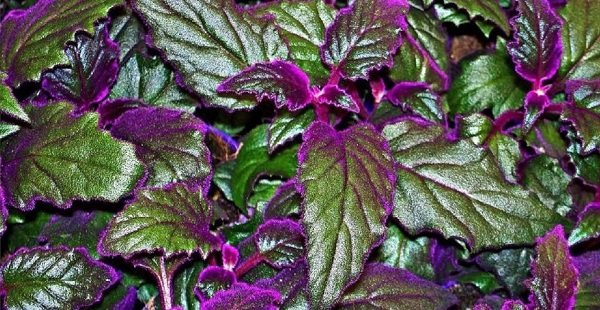
Orange (aurantiaca)
The plant is native to the island of Java. It is an evergreen shrub with branching ribbed stems. There are many purple villi on them, it seems that the ginura is in a purple cloud. The lower leaves are ovoid, 6-20 cm long, the upper ones are triangular-oval, pointed. The streaks are clearly visible.
The species received its name for the small orange-golden flowers that abundantly cover the bush. They are bell-shaped, wrapped in grassy scales. Peduncles are long, slightly pubescent. It blooms in nature almost all year round. After the flowers wither, oblong, cylindrical seeds with a long, dense tuft ripen in their place.


Wicker (sarmentosa)
Similar to orange, but smaller. The shoots of the plant are drooping, therefore it is suitable for growing as an ampelous culture.
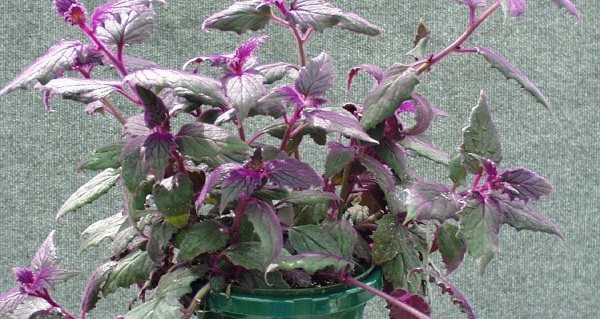

Procumbens
Perennial dwarf shrub with highly branching straight stems. The surface of the shoots is smooth, the leaves are oval, pale green, glossy, with slightly serrate edges. Despite the absence of the characteristic purple edge, the species is popular for its medicinal properties.
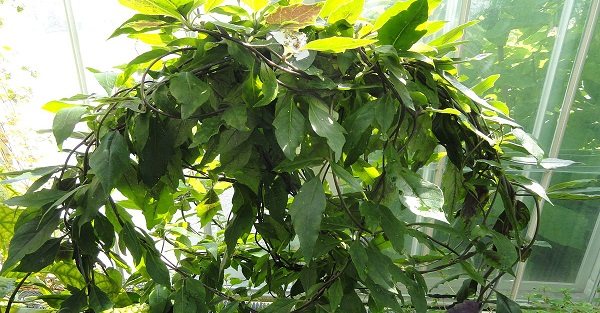

Climbing (scandens)
It is also called rising. The species is not widespread, more often found in greenhouses. Its leaves are large, oval, with sparse denticles along the edges. Scourges can grow up to 2 m in length. Looks good in hanging pots.
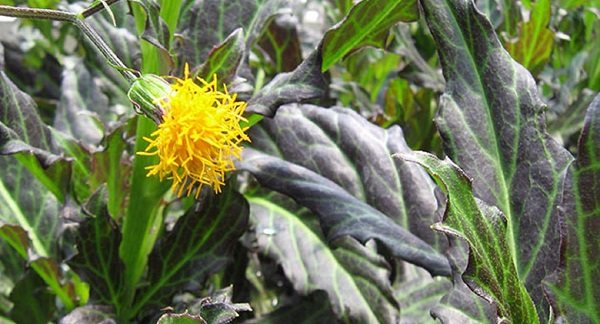

Popular types
Ginura Orange
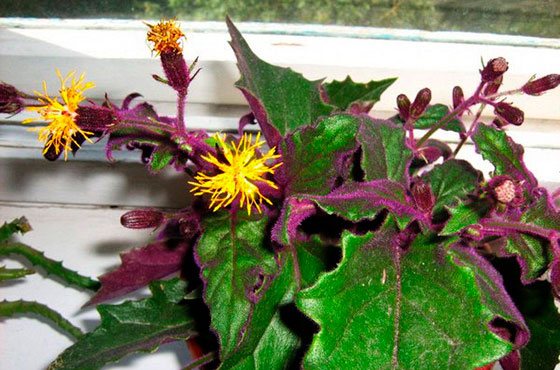

A semi-shrub with creeping stems. The leaves of this species are lilac, covered with fluff. Orange or yellow flowers are beautiful but have a repulsive scent.
Wicker
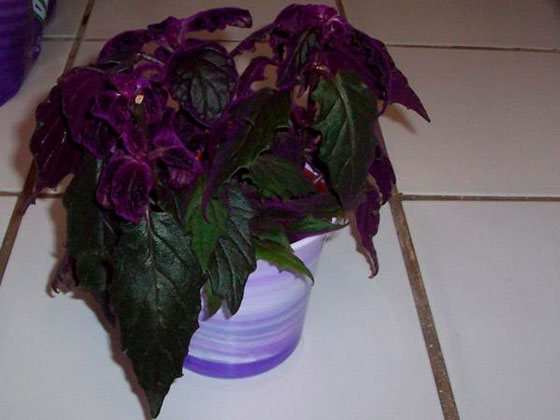

A perennial shrub, differs from the previous one in the shape of its leaves. They are soft, rounded. Purple fluff densely covers the green surface. Flowers also smell unpleasant, they are orange with a yellowish tint.
Procumbens
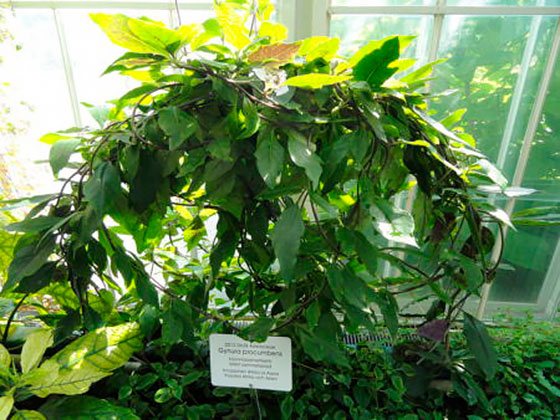

Highest view. The bush reaches a height of one meter. The variety does not have a cannon layer on the surface of the leaves; it belongs to the category of medicinal plants. The leaves are smooth with a glossy sheen, very dense.
They are added as a general tonic to vegetable salads or tea.In addition, drugs are made from the Procumbens variety (prostrate) for the treatment of kidneys, stomach ulcers, inflammation in the gastrointestinal tract, and to lower blood pressure.
Climbing
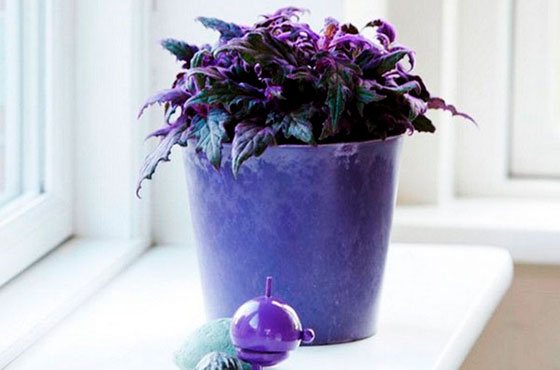

Ampel plant. The flowers are very small, orange or yellow in color.
Ginura variegated
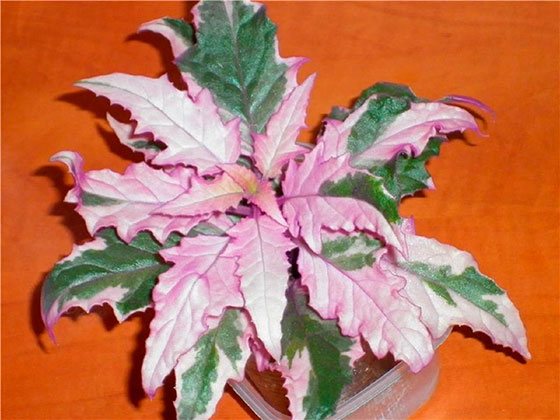

Hybrid. It is characterized by an unusual structure of leaves, dense branches. Leaves are strongly elongated, pointed. They are covered with purple fluff. In young plants, the color of the leaves is light pink, but over the years, dark green spots appear on the upper surface.
Home care
There are no particular difficulties in growing ginur. Even flower growers without much experience can take care of it without problems.
Location and lighting
The plant loves diffused light. It is better to place it on windows on the west or east side of the house. If the flower is placed on the south window, then it will have to be shaded from the scorching sun. With a lack of lighting, the ginura will lose its decorative effect. In winter, it is necessary to increase the duration of daylight hours with phytolamps. This will help to avoid stretching the shoots, to maintain the attractive appearance of the leaves.
Pot selection and soil
A medium-sized pot is suitable for ginura. The roots should not be cramped, but there should not be much free space. Otherwise, the soil will begin to sour and the roots will rot. There should be holes at the bottom for water outflow.
For planting, a universal substrate for indoor plants is suitable. If you cook it yourself, then you need to mix:
- turf (1);
- leafy ground (1);
- humus (1);
- sand (0.5).
Planting and transplanting
Ginura needs to be updated every 2-3 years. With age, culture loses its decorative effect. It acquires its spectacular appearance thanks to young stems.
Transplant procedure:
- Water the plant abundantly, wait for the water to be well absorbed into the soil.
- Prepare a pot 3-4 cm larger than the old one. Put drainage (expanded clay, pebbles) in it, sprinkle with a little soil.
- Gently remove the plant from the pot while holding the stem. It should remain with an earthen lump. Use a pencil or stick to free the roots from excess soil, do not injure them.
- Place the ginura in a new pot, add soil little by little, filling it. Gently compact each layer.
- After planting, place the flowerpot in a shaded place until the plant takes root. It is better not to water it for 2 days. After adaptation, move the flower to a brighter place.
Visual video - instructions for transplanting Ginura:
Temperature and humidity
In the spring-summer period, the temperature of + 20..24 ° C is sufficient for gynure. In a hot room, she will be uncomfortable, even destructive. From time to time, the room in which the plant is located needs to be ventilated, but drafts should be avoided. In winter, the air temperature is lowered to + 14 ° C. In such conditions, the ginura should rest until spring.
The culture is not pretentious about air humidity. If the room is hot, then it is better to moisturize it by spraying the area around the ginura. You can put a container with water next to it.
A warning! Do not spray the leaves. Water droplets will lose their decorative appearance.
Watering
During the growing season, the plant is watered abundantly. But it is impossible to swamp the soil. It is necessary to let it dry out a little between waterings. When kept in cool conditions in winter, the amount of watering is reduced. Otherwise, the soil will sour and the roots will rot. But the complete drying out of the earthen coma cannot be allowed. Use warm, well-separated water for irrigation. It is better to pour it along the edge of the pot or under the root so that it does not fall on the leaves.
Top dressing and fertilizers
Ginura is fed during the period of active growth. Complex formulations for deciduous plants are introduced 2 times a month.Species with purple pubescent leaves can be harmed by excess nitrogen. They will begin to turn green and the stems will stretch out. Therefore, before using fertilizers, you need to carefully study their composition. In winter, feeding is stopped.
Bloom
In natural conditions, ginura can occur throughout almost the entire year. The flowers are somewhat similar to a dandelion, reddish or orange in color. Sometimes the plant blooms at home. This usually happens in late spring and summer. But most flower growers prefer to remove the peduncles, since they slow down the growth of the plant, the leaves become smaller, the stems become thinner. In addition, the smell of flowers is not very pleasant and not everyone will like it.
Pruning and garter
With age, ginura loses its decorative effect, so it must be periodically rejuvenated with scraps. If you leave it to grow uncontrollably, then in the end you can get an elongated vine with thin shoots and small leaves. To stimulate branching and make the bush more lush, the tops of the shoots are pinched to it.
For the full growth of shoots, ginure needs to be supported. It can be all kinds of ladders, arches and other original structures on which the stems will be attached. If the shoots are left to lie down without a garter, their growth will slow down or stop altogether. On the supports, the bush will look more attractive.
Ginura from 100 diseases
In recent years, not only people are actively moving around the world. Both plants and their products travel. The arisen interest in the traditional medicine of Asian countries has brought to our market products from many interesting plants, which most, with the exception of, perhaps, narrowly specialized botanists, have never heard of.
Pueraria, guarana, codonopsis, ashwagandha have become almost familiar and familiar to many. But few have heard about ginura (in Latin transcription) or ginura (in English transcription), although someone is already trying to grow it on a windowsill or in a winter garden.
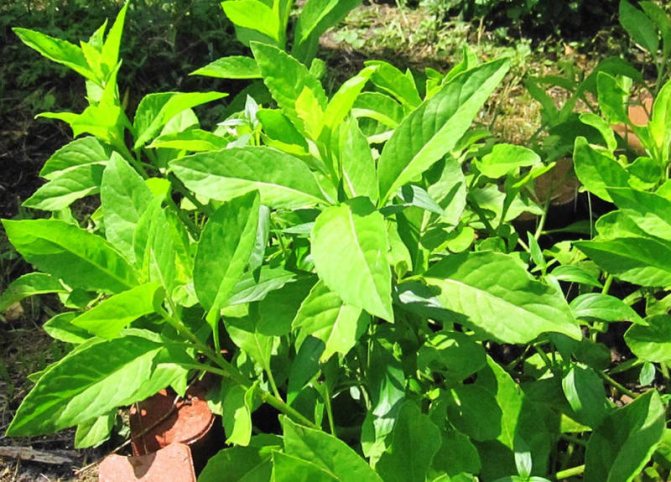

Ginura prostrate
Ginura prostrate (Gynura procumbens) is a small plant from the Aster family, 1-3 m high. The stems are fleshy, and the leaves are ovoid-elliptical or lanceolate, in my opinion, somewhat reminiscent of dahlia leaves. Sometimes in the literature it is found under the names Gynura sarmentosa and Cacalia sarmentosa, which are synonymous.
The leaves of the plant are traditionally used for food in Thailand and Malaysia. In Malay this plant is called Sambung Nyawa, which means "life extension", and in Chinese it is called Bai Bing Cao, which means "100 diseases", and it is used very widely for a variety of ailments. In Japan, ginuru is called "Okinawa spinach", and there, as you know, there are a lot of centenarians.
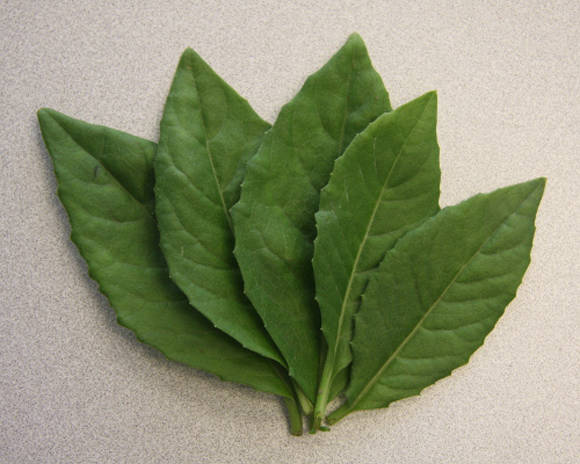

Ginura prostrate
In other countries, the healing effect of the plant has also been known for a long time: in Indonesia, it is used to treat kidneys, and in Vietnam, for fever. Current active research in many countries has provided extensive scientific evidence for the therapeutic potential of this ginura.
The beneficial properties of ginura are explained by the presence in this plant of biologically active compounds such as flavonoids and glycosides.
Based on the needs of modern civilization, plants suitable for cardiovascular diseases always come to the fore - hypertension is a key risk factor for the development of certain cardiovascular diseases, including coronary heart disease and stroke - and ginura has shown in experiments a high antihypertensive and cardioprotective activity ...
To date, it has been proven that the use of this plant leads to a significant decrease in systolic and mean arterial pressure, as well as a significant decrease in heart rate.True, experiments, albeit very deep and meticulous, to find out which enzyme is blocked and which is activated, were carried out on rats. The enzyme angiotensin leads to the formation of a peptide hormone with a strong vasoconstrictor effect, and ginura drugs inhibit its action. Another possible mechanism of the extract's vasodilating action is inhibition of extracellular Ca2 + influx. Thus, prostrate ginura potentially serves as an antihypertensive agent with cardioprotective activity due to its ability to act on various mechanisms.
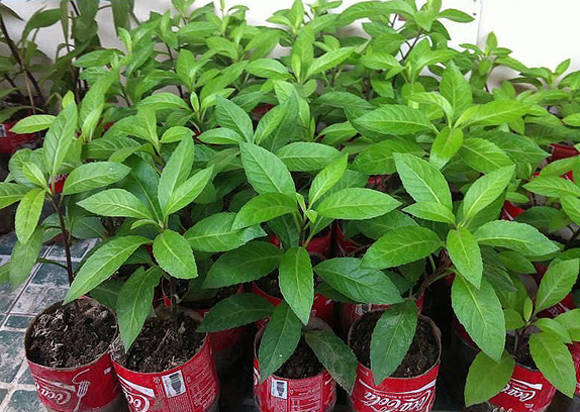

Ginura prostrate
The second big problem in our society is diabetes. The leaves of this plant are commonly used to treat diabetes in traditional medicine, and their hypoglycemic effects have been reported in animal studies. At the same time, it was precisely the regulatory activity that was emphasized, that is, the effect was present only in sick animals, and the sugar level in healthy animals did not change. Currently, researchers are arguing whether the plant extract affects the intensity of pancreatic insulin secretion. But recently, the majority is still inclined to believe that the effect is not associated with insulinotropic activity, but is due to a different mechanism of action. Other avenues in research have focused on glucose uptake activity. They showed that the consumption of glucose by muscles increases precisely in diabetic rats, and the extract of G. procumbens stimulated an increase in the utilization of glucose in the liver and a decrease in the production of endogenous glucose.
In addition to directly treating diabetes, research on ginura prostrate has also explored its potential in treating infertility, which is one of the complications of diabetes. It turned out that taking the extract significantly increases the number of spermatozoa, their motility, and reduces the percentage of their death. G. procumbens has also been shown to have aphrodisiac properties. Ginura can improve the fertility of infertile diabetic men, especially by increasing sperm count, quality and motility.
Ginura common has long been used for traditional cancer treatments in Asian countries, such as leukemia, uterine cancer, and breast cancer. This provoked extensive scientific research into its anticancer activity. In most cases, the experiments did not go beyond the laboratory, but in many cases they confirmed the people's experience. It was found that short-term (10 weeks) treatment with an ethanol extract of the plant suppressed the progression of nitroquinoline-1-oxide-induced tongue carcinogenesis during the initiation phase. A longer period (26 weeks) of administration has been shown to result in a strong suppression of oral carcinogenesis. Ethanol extract proved to be effective against the carcinogenic effect of 7,12-dimethylbenz (a) anthracene on the liver and on the osteosarcoma cell line. Recently, an ethanolic extract of G. procumbens has been shown to have some potential in the prevention of colon cancer, and has also demonstrated its potential in the prevention of breast cancer. It has been shown to effectively suppress the proliferation of breast cancer and mammary epithelial cells. In addition, further studies have shown that treatment with G. procumbens can reduce the incidence of tumor in the test animals.
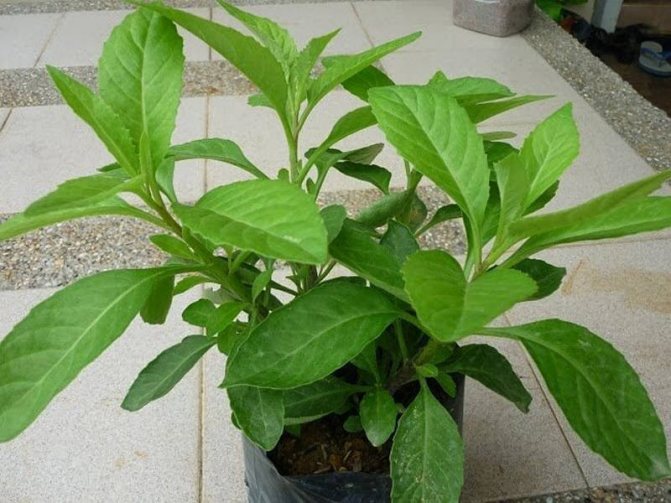

Ginura prostrate
Most studies have concluded more about the preventive effect of the plant. Patients with cancer often use herbal medicine as complementary and alternative medicine when undergoing chemotherapy. In this regard, studies were conducted on the combined use of ginura and chemotherapy drugs.In studies by Japanese scientists, the combination of ginura extract with doxorubicin or 5-fluorouracil led to a strong synergistic effect against breast and colon cancer cells, but when combined with ginura extract with cisplatin, it turned out that they act as antagonists. This shows that the simultaneous use of G. procumbens with different chemotherapy drugs can lead to different treatment efficacy. So the researchers still have a lot of work to do.
The antimicrobial activity of ginura is worthy of separate studies. Studies show that ginura extract is active against Plasmodium falciparum 3D7 and Plasmodium berghei NK65 strains of malaria. In addition, it has been demonstrated that an ethanol extract of parts of aerial plants exhibits virucidal and anti-replicative activity of herpes simplex HSV-1 and HSV-2. This was confirmed in a clinical study in patients with recurrent herpes of the lips treated with herbal gels with G. procumbens extract. Antibacterial activity has been found against gram-positive and gram-negative bacteria such as Bacillus cereus, Pseudomonas aeruginosa, Vibrio parahaemolyticus and Salmonella typhi. Antifungal activity was noted against the causative agent of thrush Candida albicans and the mold fungus Aspergillus niger. The results of these studies provided evidence of the validity of the traditional use of ginura for malaria and herpes.
The antioxidant activity of the extracts was assessed using the DPPH assay to measure its ability to scavenge free radicals. In a comparative study, ethanolic extract of G. procumbens showed a very high percentage of DPPH inhibition (52.81%). Further study of antioxidant activity using a number of different analyzes showed that ginura exhibits significant antioxidant activity. Research has shown that root extract has the highest antioxidant activity compared to other parts of the plant. Thus, in numerous and varied experiments, it has been established that ginura is a powerful source of natural antioxidants, probably due to its high content of phenols.
Found that ginura has a gastroprotective effect in gastric ulcer, with a decrease in submucosal edema. This discovery has intrigued researchers to further investigate the protective effect of the plant's preparations. Later, a protective effect on the skin was discovered when exposed to ultraviolet light. researchers are particularly interested in the hepatoprotective effect, as it has been shown to attenuate ethanol-induced lipid accumulation in the liver.
In Thai traditional medicine, G. procumbens is commonly used to treat inflammation. Topical application of ethanol extract to the wounds of the test animals showed significant signs of skin healing, a smaller scar width and a significantly faster healing rate compared to the saline control group). In addition, histological analysis also showed that there are fewer inflammatory cells and more collagen in the granulation tissue of the wound.
Depending on the dose used in the experiment, ginura acted either as an immunostimulant or as an immunosuppressant. Therefore, the anti-inflammatory and immunomodulatory activity of G. procumbens can be used to treat inflammatory diseases or conditions in which the immune system is involved.
Among the existing patents mentioning this plant, most of them refer to traditional Chinese medicines for the treatment of various diseases, including uterine cancer, cervical spondylosis and chronic skin diseases.In addition, it has also been used as an ingredient in special diets for patients with cardiovascular disease and liver disease.
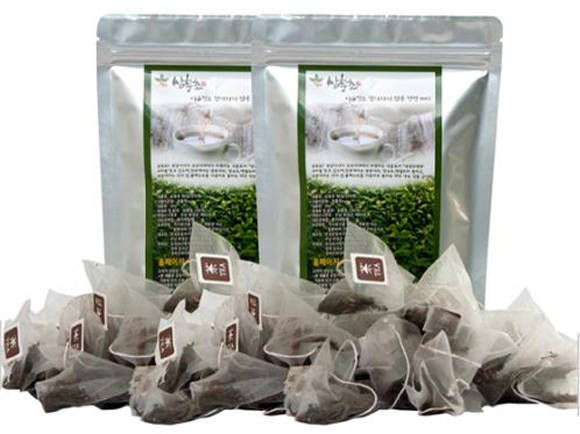

Ginura tea
In the food industry, ginura is included in foods such as tea, kimchi (a Korean vegetable dish), coffee powder, chocolate, candy, and chewing gum. There is also information on the use of G. procumbens in personal care and cosmetic products, including hand wash solution, hand sanitizer, mouth spray, face masks, and skin care creams. These patents demonstrated the high commercial value of G. procumbens and the variety of its applications in a number of industries.
Considering that for centuries the plant has been food, it is probably worth paying attention to it as a potential product for maintaining, if not eternal, but long-term health.
|
|
Reproduction methods
You can grow ginura from seeds or using cuttings. But the seed method is used only by experienced breeders to develop new plant varieties. At home, it is ineffective.
A simpler and more reliable breeding method is cuttings. Pinch off a shoot 8-10 cm long from the mother bush.There should be no more than 4 healthy leaves on it. Remove the lower leaves, treat the stalk with a rooting stimulator (Kornevin or Epin). Take a small pot, put drainage and disinfected peat-sand mixture in it. Make a hole with a stick, stick the handle halfway into it. Drizzle abundantly and cover with foil. Take off the shelter for 5-10 minutes every day. Make sure that the substrate is moist at all times. When the cutting takes root, transplant it into a permanent container with a suitable soil mixture.
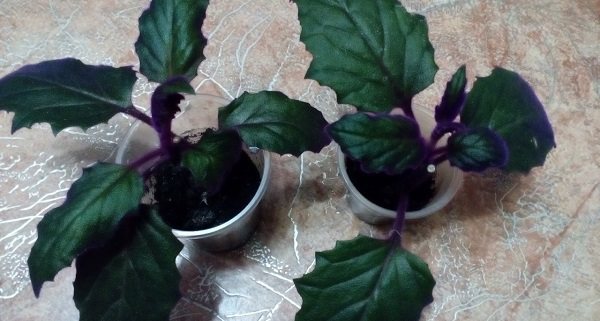

Ginura: description
Ginura - lat. Gynura
The plant is a herbaceous evergreen perennial shrub belonging to the Aster family. The native land of the plant is Africa, but it is also widespread in the green tropical zones of Asia.
In nature, erect or slightly climbing stems of ginura reach a height of 2-3 meters. Leaves are dense, petiolate, oblong, with carved jagged edges. In the wild, the shrub blooms almost all year round, with the most abundant flowering period from December to June. Flowers are solitary, in some varieties they are collected in axillary panicles. The color of flowers is orange, yellow, red, purple, lilac.
In appearance, the bloom of ginura is completely nondescript, and besides, the smelling is not very pleasant. Many growers immediately pick off the buds, not even letting them bloom.
Botanists have counted about 50 plant species; only a few of them have been domesticated for home cultivation.
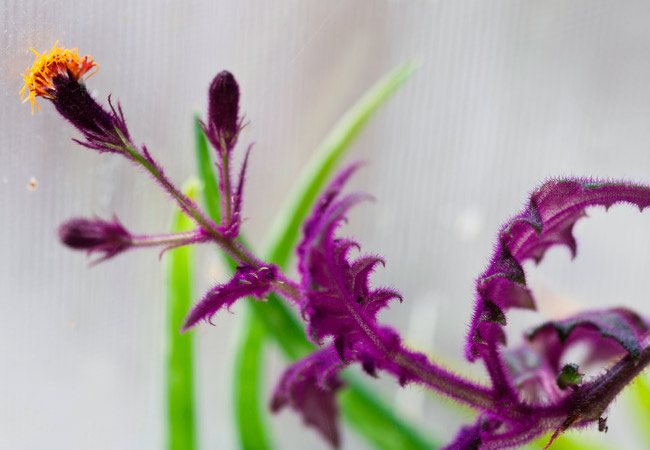

Ginura: description
Features of seasonal care
Ginura grows actively in spring and summer. During this period, she needs a lot of light, temperature + 20..24 degrees, regular watering and feeding. Since autumn, all processes of the plant slow down, it prepares for rest. In winter, you need to provide suitable conditions for rest. Reduce the air temperature to + 14..16 degrees. If this is not possible, then just put the flowerpot as close as possible to the cold window, away from the heating appliances. Horses must not be overcooled. It is better to put the pot on a stand made of polystyrene or wood. Top dressing during the dormant period is stopped completely, watering is significantly reduced. The lower the room temperature, the less often the flower needs to be watered. Lighting should be sufficient even in winter. Therefore, it is necessary to provide additional illumination using fluorescent and phytolamps.
Photo
See further photo of the Ginur flower:
Care errors and their elimination
Common problems when growing Ginura and methods for solving them:
| Problem | The reasons | Decision |
| Loss of variegated leaves | Lack of lighting | Move the flowerpot to a bright place |
| Falling leaves | Drying out of the soil | Increase the number of waterings |
| Shrinking foliage, pulling leaves | Poor food and lighting | Fertilize ginura regularly during the growing season, provide plenty of light |
| Brown or gray spots on the leaves | Water ingress | Water the plant under the root or along the edge of the pot |
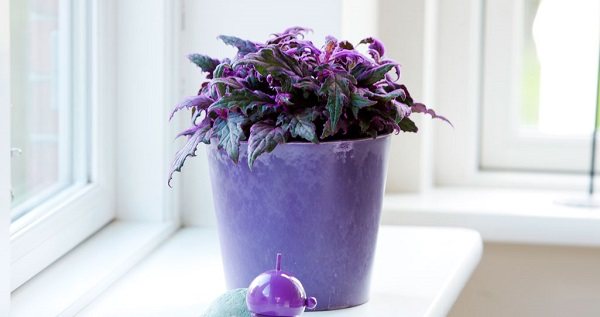

Pruning, fertilizing, transplanting, reproduction
At the onset of the spring season, the ginurs must be cut off, giving the bush a neat look and showiness. Pruning contributes to the lushness of the bush and stimulates its growth. This is not difficult to do, it is enough to pinch the upper shoots.
When a plant is actively growing and developing, it needs support with feeding. They are brought in during the period from March to August at intervals of 14 days. For feeding, you will need complex mineral fertilizers. When the plant is resting, no fertilization is needed.
The transplant is carried out in the spring, if necessary. Since over the years the spectacular purple color on the leaves begins to fade, it is necessary to carry out rejuvenating transplants to adult bushes. This can be done no more than once every 2 years.
In order to propagate ginur, it is necessary to use the grafting method, since this is very quick and easy to do. In the spring or summer, you need to cut off the top of the cutting with 2 internodes and lower it into the water. After a couple of weeks, the cuttings will have roots and can be planted in a pot.
Diseases and pests, control methods
Ginura has a strong immune system and does not get sick often. Problems can arise if the rules of agricultural technology are violated. With waterlogging of the soil and hypothermia of the roots, the plant can get sick with root rot, powdery mildew. First of all, you need to reduce watering. Remove all damaged parts of the bush, treat it with a fungicide (Fitosporin) and transplant it into a fresh substrate.
Ginura pests:
- shield;
- aphid;
- mealybug;
- spider mite.
Due to the edge on the leaves, the plant cannot be bathed in the shower. Therefore, the fight against parasites should be started immediately with the use of broad-spectrum insecticides:
- Actellik;
- Decis;
- Aktara;
- Karbofos;
- Fitoverm;
- Kinmix and others.
Re-processing should be carried out in a week.
Pest control
Ginura has a strong immune system that easily copes with diseases and resists harmful insects. A plant can become sick and attacked by pests if it is poorly cared for and kept in conditions that are not suitable for it. In this case, Ginura will weaken and the scale insect, white-winged, aphids, spider mites and mealy bugs will be able to settle on it.
Shields, these are small sucking insects that suck all the juices from the flower. Due to their fault, the foliage turns yellow and falls off in a short time. The bush stops developing and begins to lag far behind its "brothers", then it dries up and dies. You can cope with the disease by treating the plant with insecticidal preparations in time. If once is not enough, then re-processing is carried out after 7 days.
Whiteflies, these are small white moth-like moths laying their eggs on the leaves. Insecticidal preparations will help to cope with these harmful insects.
Mealybug, it is also called a hairy louse. A small insect that sucks juices from leaves. After them, you can see whitish spots similar to wax. Where this pest settles, development slows down. There are also such species that affect the root system and then the disease can only be detected by developmental lag. An insecticide will help to cope with them.
Spider mite- this small harmful insect is capable of causing a lot of harm to all plants except aquatic ones. It is a sucking insect along with scale insects and scale insects. They are very small and it is almost impossible to see them without using a magnifying glass. But you can understand that they can be on the plant on the seamy side of the leaves.If there are whitish blotches on it and the thinnest cobweb is present, then there is a tick on the plant. They are capable of causing great harm, as they often carry dangerous viral diseases that cannot be cured. Therefore, if they are detected, it is necessary to immediately start treating the plant with insecticidal preparations.
Aphids you can find it on plants quite often, since it does not disdain practically any types of crops. This insect sucks sap from plants and is capable of infecting them with dangerous diseases. It can also be dealt with with preparations based on insecticides.
Ginura in the house: signs and superstitions
Like many indoor crops, ginuru is endowed with certain properties. It is often called "crocodile" because of the unpleasant smell of flowers. But, despite this, the plant is able to absorb negative energy, cleanse the home aura. Fans of esotericism are sure that bad-smelling flowers protect amorous people from making mistakes. Therefore, it is not recommended to cut them off. Ginura is also considered a symbol of female happiness.
Some types of ginura have medicinal properties. For example, Peristonadreznaya ginura is grown on an industrial scale in some Chinese provinces to obtain raw materials that contain amino acids, saponins, bioflavonoids and other beneficial substances. Funds from this plant are widely used in China, Japan, America. They help to fight overweight, high blood pressure, lower blood glucose levels, and purify the blood. Ginura leaves are added to salads as an additional source of vitamins.
Ginura is an ornamental plant that attracts the attention of flower growers with its beautiful foliage. It can be grown as an ampelous crop or tied up on a support, forming a lush bush. Taking care of your culture is easy. The main thing is to provide it with good lighting, moderate watering, top dressing, rejuvenate the stems in a timely manner, and give it the opportunity to rest in winter.
Want to know more about growing Ginura at home? Watch the following video:
Important caveat
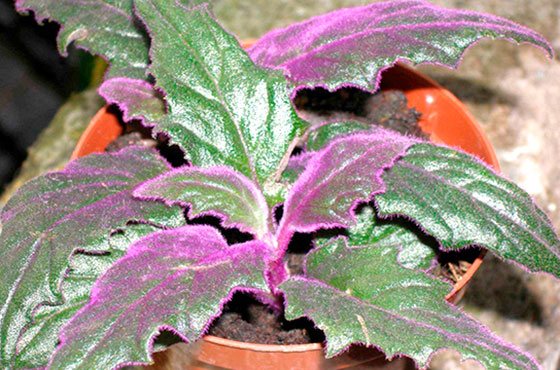

Can such a flower be kept at home? All types of ginura are poisonous. More precisely, their juice is poisonous. Take care of this flower, especially during pruning, only with rubber gloves.
If you have small children in your family, then do not risk it, refrain from growing this flower. If a baby chews a leaf of this plant, then the consequences will be very sad.
Pruning
Ginura species that do not grow in ampelous form need a garter, since its shoots do not hold their shape well and lie down. This not only spoils the appearance of the flower, but can also lead to a premature stop of its development. In addition to tying up, the plant needs pruning, and this applies to all its forms. It is necessary to regularly pinch the tops of the shoots to stimulate the growth of the lateral shoots and form a thick and beautiful shape. If you allow the shoot to stretch out to its full height, then at the base it will begin to bare, and the picture will become unsightly. Pruning is done in the spring. This is the best time in terms of vegetation, and besides, it is after a dark winter that the shoots are noticeably stretched.
Temperature
An important condition is a moderate temperature: + 20-25 ° C in summer.
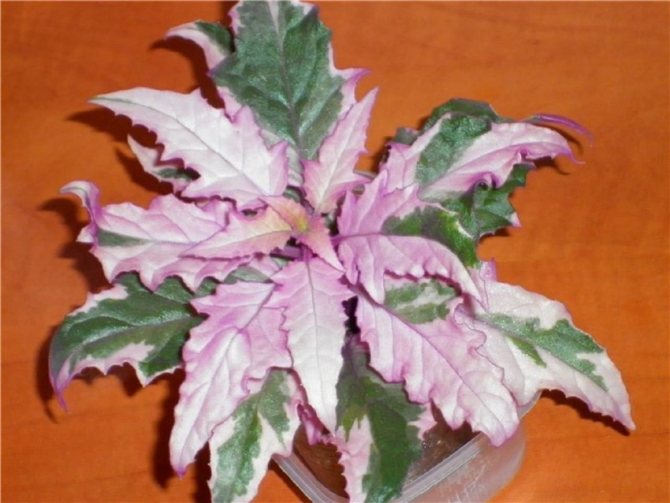

In winter, + 12-14 ° C, but a lower temperature is detrimental to the plant. Ginura is afraid of drafts, but more often it is necessary to ventilate the room.
Photo gallery
The flowers have an unpleasant odor, so they break off when buds form.
Possible problems
- Loss of bright pubescence - the most common cause is a lack of lighting.
- Leaves are falling - the specimen is too old or there is a lack of watering.
- Leaf plates become shallow - poor soil or lack of light.
- Too elongated bald shoots - not enough light or the necessary spring crown molding has not been done.
- The appearance of brown spots on the leaves - water got on them during watering or spraying was carried out, henceforth it is necessary to exclude the ingress of moisture on the leaves and shoots.
Transfer
Frequent transplants for ginura are a necessity, but it makes no sense to set the frequency according to certain recommendations. Better to do it as needed. As soon as the roots completely fill the pot, then it's time for housewarming. Sometimes the plant grows poorly, in which case it can be left until next spring. It is early spring that is the optimal time for transplanting. At the same time, the level of the root collar is left at the same level, increasing the volume of the pot and not forgetting the need for a wide drainage layer.
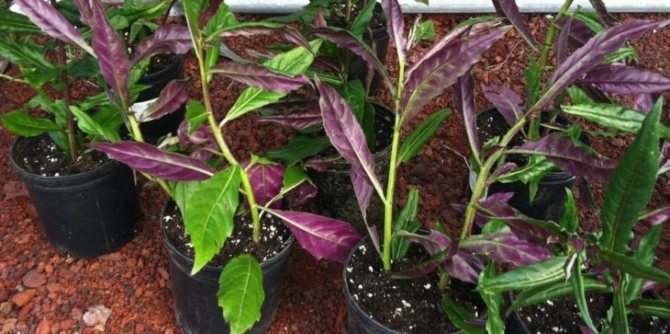

How to create an optimal microclimate depending on the season?
Like many plants, ginura has a dormant period. Therefore, the required conditions, depending on the season, are slightly, but still differ. The flower is undemanding to air humidity, the main attention should be paid to proper watering.
Table: how to care for a plant depending on the season
| Parameter | Winter | Summer |
| Lighting | Bright diffused light. In most of the territory of Russia, natural lighting is not enough, so you will have to use fluorescent or special phytolamps. | East or west window. Ginur will not grow in the back of the room and on the north window. |
| Air temperature | 16-18 ° C. The lower limit is 15 ° C. | 20-24 ° C. Although, in principle, ginura will endure any heat without much damage to itself. |
| Watering | About once every 5-7 days, only at the root, with drying out of the soil by 4-6 cm. | Frequent and not abundant, only at the root, with drying out of the soil by 2-3 cm |
| Top dressing | Not carried out. | Universal fertilizer for decorative leafy indoor plants every 2 weeks. |
| Air humidity | It does not need spraying, it transfers dry air calmly. | Air humidity is not a critical parameter for plant development. In extreme heat, you can put containers with water next to it or place wet moss, pebbles, expanded clay in a pallet. Spraying the flower is strictly prohibited. |
Lighting
Ginura cannot live without bright sun or additional lighting in winter. With a lack of light, the plant loses its purple charm and villi.
The direct sun needs to be shaded, but backlighting is needed in winter.
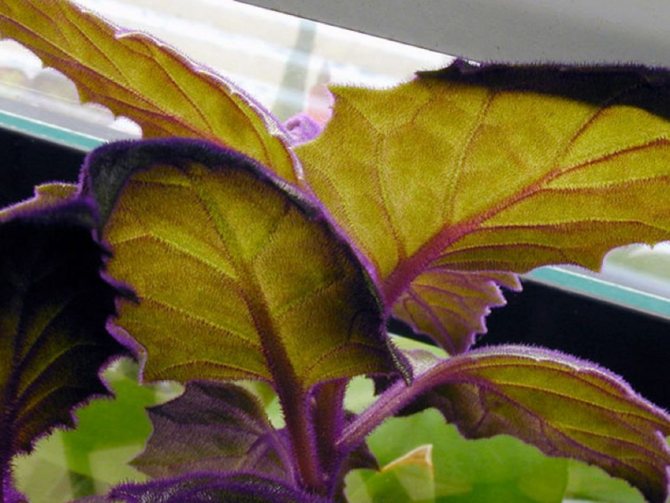

Rejuvenation
If the ginura has lost its attractiveness, the foliage has become smaller, the old leaves have changed color, then a rejuvenation procedure should be carried out. Rejuvenating pruning is also carried out if the room lighting is not bright enough, the flower has been in such conditions for a long time and is too stretched out. When cutting, 3-4 internodes are left on the lash, and everything else is cut off. You can also remove old leaves that are closer to the roots. Only one old sheet can be removed from one stem.
It is advisable to combine rejuvenating pruning with a transplant. The dish is taken a little larger, and the roots are freed from the old earth only partially. A drainage layer must be placed on the bottom of the bowl.
If ginura is already many years old, then instead of a rejuvenating procedure, you can grow a new one instead of the old plant.
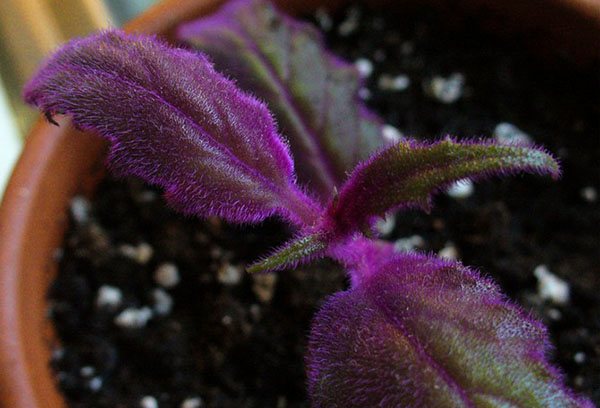

Ginura Orange (Gynura aurantica)
It is a semi-shrub with climbing stems that have luxurious purple hairs. Saw-shaped foliage of wonderful purple color. The lower leaves are up to 20 cm, and the upper ones are smaller, adjacent to the stem. It blooms with yellow (orange) flowers with an unpleasant odor.
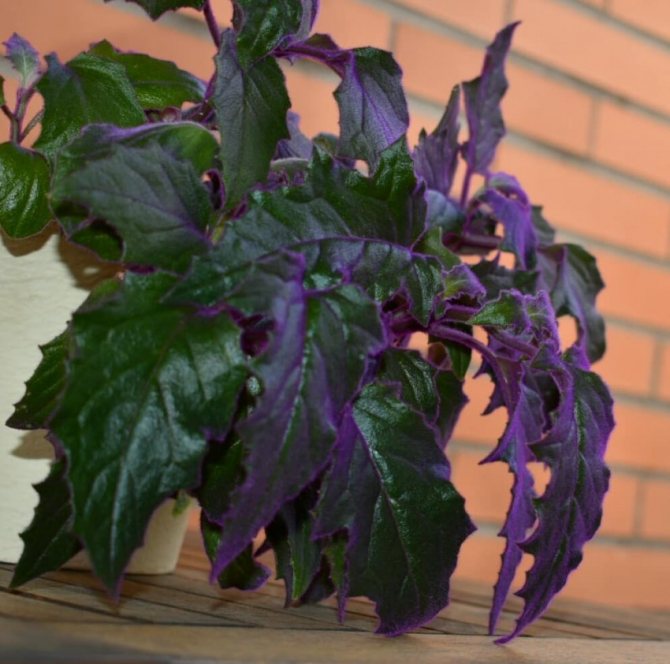

Although a capricious plant, thanks to its unusual beauty, many growers successfully plant it at home. Create favorable conditions for ginura, and she will amaze the owners with her purple soft tenderness.


Make sure of the uniqueness of the flower and the different types in the photo of the ginura below.

